Dean W. Arnold’s newest book is available on Amazon. More info here.
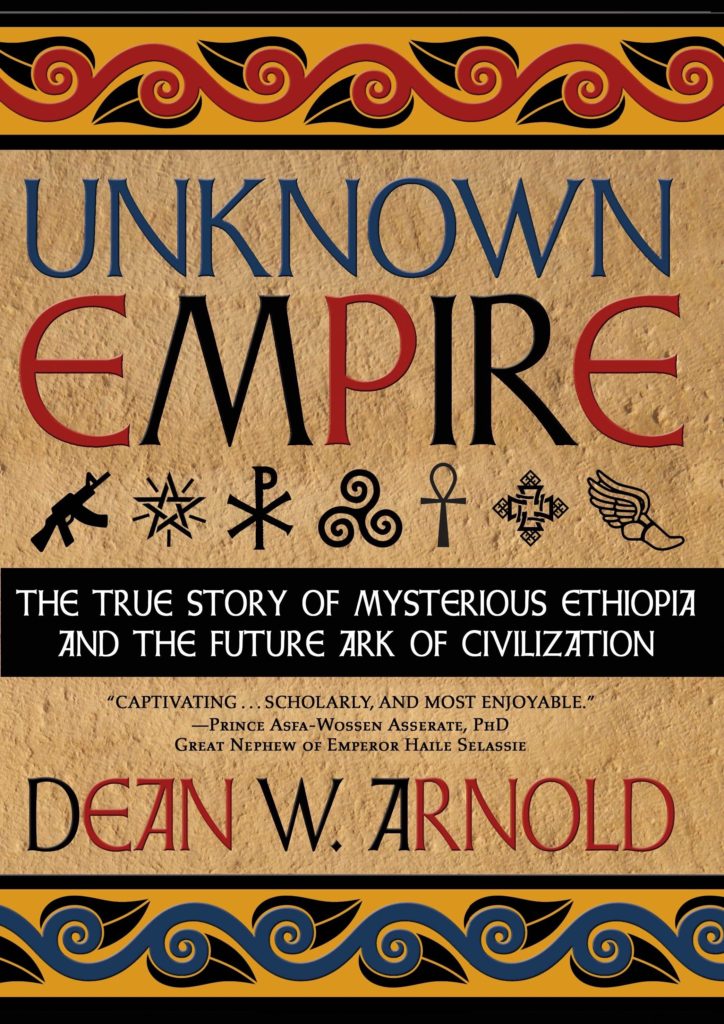

The insights and inventory of Dean W. Arnold
Gabriel is 19, and finishing up his civil engineering degree after studying algebra, trig, and advanced calculus. He attends University of Axum, 15,000 students. They speak exclusively English in their classrooms.
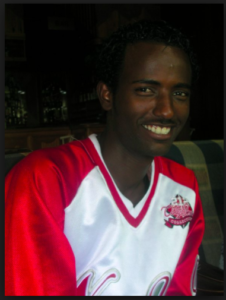
When he was 8 years old, he began shining shoes on the street to help bring in money for his family to survive. They used to run a vegetable stand but it became unprofitable. His father lost an arm in the war to overthrow the communists.
They added to their compound over the years by building a few rooms to their living quarters. Family members did the work, using stones and mud for the walls with a metal roof.
He lives in one room with his parents and his brother. (Two older siblings have moved on.) He sleeps on the floor. In the larger compound, there are three other rooms serving 12 or so people. They all share one toilet. There is no running water. Continue reading “Church, struggle, and Ethiopian families (day 8 – Dean in Ethiopia)”
Sola Scriptura Article:
Mary as Ever-Virgin article:
Click here to support a Reverse Missions Trip to Ethiopia.
Why do I have such a strong interest in Ethiopia?
Because they can help us. Because they have much to teach us. Because we will soon need them. Details to follow below.
However, the origins of my interest probably began with a prayer and a curiosity I had about ten years ago. Having for two decades grown more concerned with the alarmingly low birth rates in the West—and thus Western Civilization’s decline and it’s inevitable defeat by the ever populous eastern nations—I began to wonder where on the map there is indeed a growing birth rate along with a majority Christian population.
For me, that question also requires an historic Christian nation, as I embraced Orthodox Christianity two decades ago. Yet there are in fact a couple of what you might call majority Christian nations of the Protestant stripe. South Korea has many devout believers. Sadly, their birth rate has declined from very high a few decades ago to a stunning 1.3 children per woman, far below even the replacement rate of 2.1. Another candidate is Nigeria, the most populous nation in Africa with also one of the highest birth rates. Nigeria has many Christians. But the country itself is not stable. Visitors find it dangerous. And for me, without a long tradition to steer it, Nigeria didn’t make the cut.
Sadly, historic Orthodox countries like Russia and Greece have low birth rates. Russia is recovering at 1.9, up from 1.2 in 1991 when Communism collapsed. Greece is at 1.3 with no sign of a rise. It’s future is very bleak.

So when I started looking at the map and praying about this question—and studying birth rates and demographics—I saw that Ethiopia was the only country that really provides a hopeful future for Christendom. With five children per woman, and a 2000 year Christian tradition starting with the Ethiopian Eunuch in Acts 8—and centuries of Judaism before that—this nation began to capture my heart.
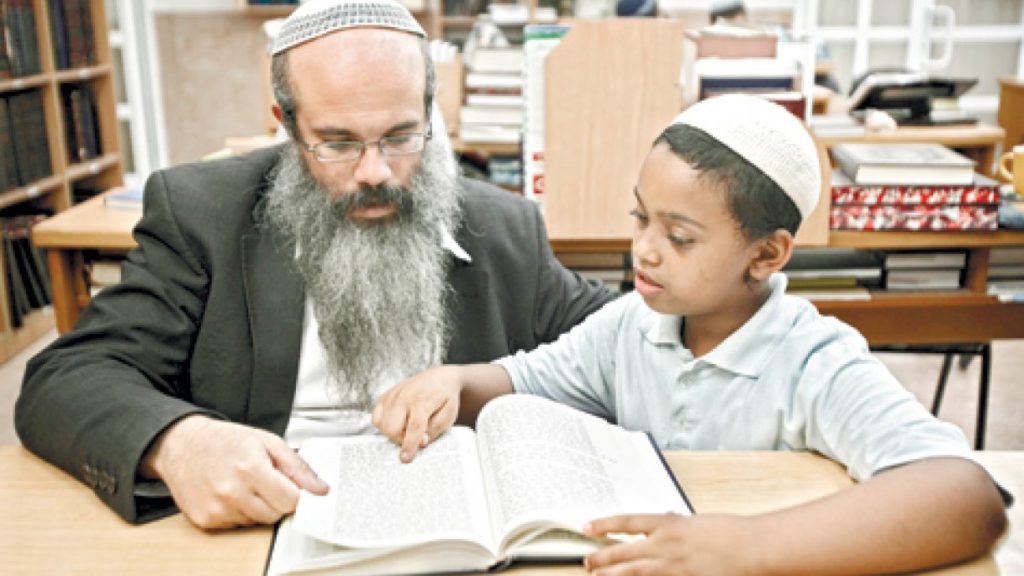
Ethiopia can teach us and bless us in three ways:
1. Spiritual insight. With over 1000 monasteries in the country, Ethiopia is full of men and women who spend all their time seeking the face and heart of God himself. This is a key component, a central part of what the Christian Church has always done throughout the centuries. Such devoted prayer is of course a lost art today. Many Orthodox and other Christians desirous to learn from those consecrated to God in this way visit Russia and Greece and a few other countries with a monastic tradition. Some, like Egypt, have lost their Christian majority to Islam. Others, like Russia and Greece, have uncertain futures. Will there be people for their monasteries, which are even now in need of more monks? Ethiopia provides this light to the world, and their future looks bright as well.

2. Defying Modernism. While Western Christians bemoan the slide of our culture into abortion, homosexuality, and now transgender and other absurdities, Ethiopia stands firm on the traditional values of strong families and biblical sexuality. Both adultery and homosexuality are criminal offenses. The church publicly condemns contraception. Traditional male and female roles are the norm.

They can also teach us how to relate properly to Islam, arguably the most critical issue of our time. While 50 percent of the nation is Orthodox and 65 percent Christian, 35 percent of Ethiopia is Muslim. These two religions get along admirably, in general, and have for 1400 years. But while this involves a peaceful tolerance of Islam among their ranks, Ethiopia does not hold a relativistic “we are all the same” attitude either. Ethiopia is Christian. They crack down quickly on militants (it happens occasionally). They make no apologies for their laws based on Christian beliefs. What Western Christian nations exhibited a century ago before modernism—a firm, tough, but loving and tolerant hand—is what Ethiopia models today toward Muslims.

3. An Ark for the future of Christendom. Ethiopia is legendary for insisting it preserves the Ark of the Covenant in Axum, their religious capital. But I am proposing that they also may be holding for us another Ark, like the one Noah built. Where will Christians go if the secular and godless West goes the way of the Communists and the Bolsheviks, if persecution breaks out? Ethiopia provides a valid option.
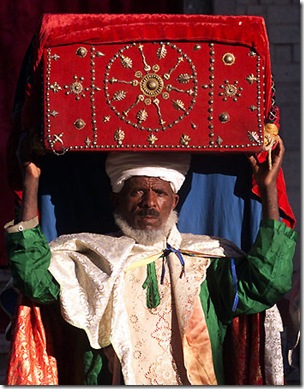
Just as importantly, an Ethiopian diaspora may affect the rest of the globe for positive Christian advancement in the same way the Jewish and Greek diaspora changed ancient culture and the way the Chinese diaspora is helping prepare that superpower for a new Chinese World Order. To do this, you must have many people. Ethiopia is slated to have nearly 200 million people by 2050, 50 million more than Russia. This would make Ethiopia the largest historic, majority Christian nation on the planet. The Ethiopian Church may indeed be the Ark for modern Christianity’s future. I suggest we find a way to hop on.
In light of these three Ethiopian blessings for Westerners, I am dubbing my trips to Ethiopia “Reverse Mission Trips.” Often when I tell people I am traveling there, they ask, “Is it a missions trip?” I respond, “It’s a reverse mission trip.” Sometimes I explain, and sometimes I leave them scratching their heads.
The Reverse Mission Trip concept has the great advantage of reversing also the mentality of superiority so prevalent in the West toward Africa. I have no problem admitting the obvious superiority of European culture, at least currently, in terms of technology, military power, medicine, invention, and other important spheres. But this does not make us superior overall.
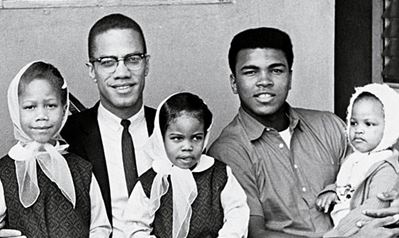
Has not God said that he made the poor “rich in faith”? What can we learn from Ethiopians in the realm of faith? What can an organic, agrarian culture teach a superpower that is poisoning itself with genetically modified food? What can a sane traditional culture teach a country insisting that bathrooms for transgenders be built in every public building?
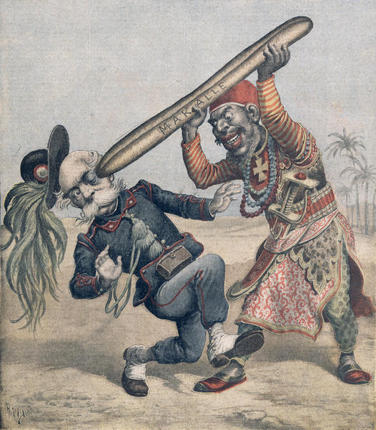
Just a couple of decades ago, Ethiopia was named the poorest country on earth. Is Jesus’s notion that “the last shall be first” just rhetorical, or is there something more to it?
Ethiopia is the only African country that was never colonized. Italy invaded twice, in 1892 and 1935, but failed both times. While the colonial West looks down its nose at the rest of conquered Africa, even that rationale is unavailable for Ethiopia. Let’s model a shift from that unsightly view of Africa and take some Reverse Missions Trips. Shall we?
***
Please consider an option below for supporting
REVERSE MISSIONS TRIPS to Ethiopia!
* All gifts are tax deductible. Make checks to Chattanooga Historical Foundation
c/o Dean Arnold; 4604 Conner St; Chattanooga, TN 37411. Also note: these donation suggestions (like “Buy a book” “Resources for Dean’s book” etc.) are suggestive and not conclusive. In other words, if a couple people give $245 for the resources, other such gifts will go to the general fund. There is a trust factor here, and I promise I’m good for it.)
$18 – Buy a book
I spoke to 100 seminary students my last trip. They are desperate for Theology books! The head academic dean of the major seminary in Ethiopia (3000 students) asked me to please bring them theology books. Thanks for considering a sponsorship of a book. They will love it!
Reward: Good feelings. No tangible reward for this, ha ha. The numbers just don’t work for buying the book, getting an item for you, baggage space on the return trip, and shipping it to you. But what you WILL get is what I’m told is the primary product sold by non-profits—good feelings. 😉
$45 – Help travelers be generous
This may seem like an odd sponsorship, but Ethiopia is indeed still a poor country, and many, many people are on the streets with their hands out asking for money. When I hand them the equivalent of 25 cents in our currency, they are ecstatic. Your gift for this aspect of the trip will allow us to bless these people and represent well for American Christians.
♦ Reward: Wood Ethiopian necklace cross. These are cool and really do capture the Ethiopian feel.
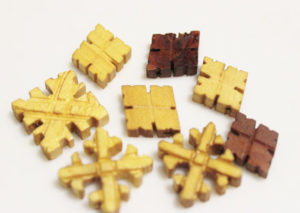
$90 – Sponsor shipping of Books
The books we acquire must get to Ethiopia. I am working on a copy of all the church fathers. The best way is in a suitcase with travelers, but those can cost extra money as well. Please consider helping us ship the books.
♦ Reward: Small brass necklace cross. These are beautiful. My wife and I both wear one 24/7, as do four of our close friends that we provided these for (mine brass, theirs silver). The late iconographer at our church (an art professor), as one of his final acts, mounted a similar, larger metal cross I had brought back, noting how exquisite it was. And he knew his art.
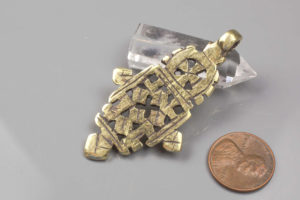
$245 – Sponsor books and resources for Dean’s book on Ethiopia
I am writing a book on all this. Working title: Ethiopian Ark: Christianity’s past and future. It will be a non-profit venture. At this early stage, there are books I need to buy for research, but some of them cost as much as $50 to $75. Your contribution here will green light my efforts.
Reward: Larger silver necklace cross. These are beautiful. My wife and I both wear one 24/7, as do four of our close friends that we brought home to them. Our late iconographer at our church (an art professor), as one of his final acts, mounted a similar, larger metal cross I had brought back, noting how exquisite it was. And he knew his art.

$415 – Sponsor one flight to the Monasteries
Once we fly into Addis Ababa, we need to take another domestic flight to the North where most of the historic areas, holy sites, and monasteries are located. Your contribution will empower someone to cover that cost.
Reward: Small hand painted icons in hand carved case: This is where it really gets interesting. These pieces are so fantastic. Authentic. They are probably worth ten times what I can buy them for in Ethiopia. You want one. 😉
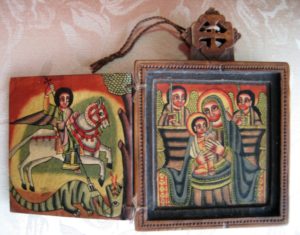
$950 – Sponsor one International air fare
A flight to Ethiopia costs around $950, depending on when you buy it, how many stops, etc. I need people to go with me. This major ticket item is the key obstacle. If you feel up to sponsoring an international flight, this would be a major blessing to the project.
Reward: Larger hand painted icons in hand carved case: This is where it really gets interesting. These pieces are so fantastic. Authentic. They are probably worth ten times what I can buy them for in Ethiopia. You want one. 😉
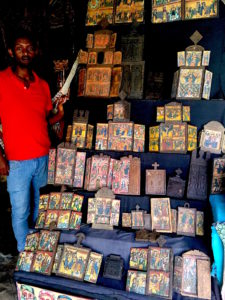
$2500 – Sponsor one traveler’s entire trip
The total cost for a trip includes the international flight, a domestic flight, room, board, taxi fare, tour guide fees and a few other intangibles that add up to approximately $2500. A gift of this amount would allow someone with very little means to join us in Ethiopia.
Reward: Larger hand painted icon in hand carved case AND a very large hand painted canvas.
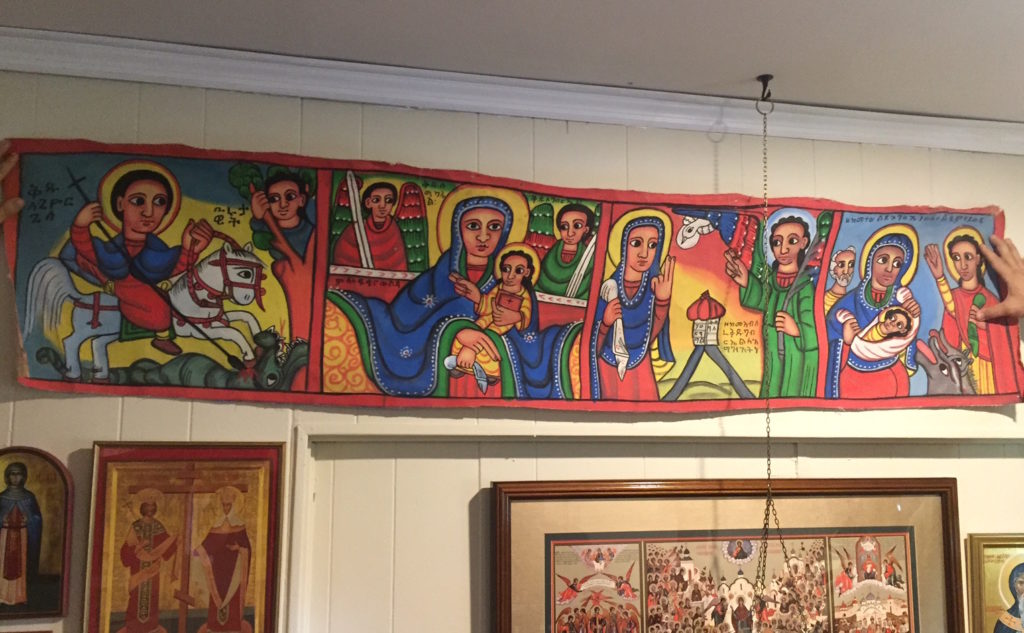
$5000 – Sponsor a professor/clergy/monastic to come to America
I have relationships with clergy, professors, and monastics in Ethiopia. America would be blessed to have one of them visit our country for a sabbatical term. If you feel led to provide a gift of this amount, it will take to the next level our desire to see more interaction between Ethiopia and America, and between the Eastern and Oriental Orthodox.
Reward: Larger hand painted icon in hand carved case AND a very large FRAMED hand painted canvas. These large canvasses are very tricky to frame. I’ll make it happen for you and get it to you.
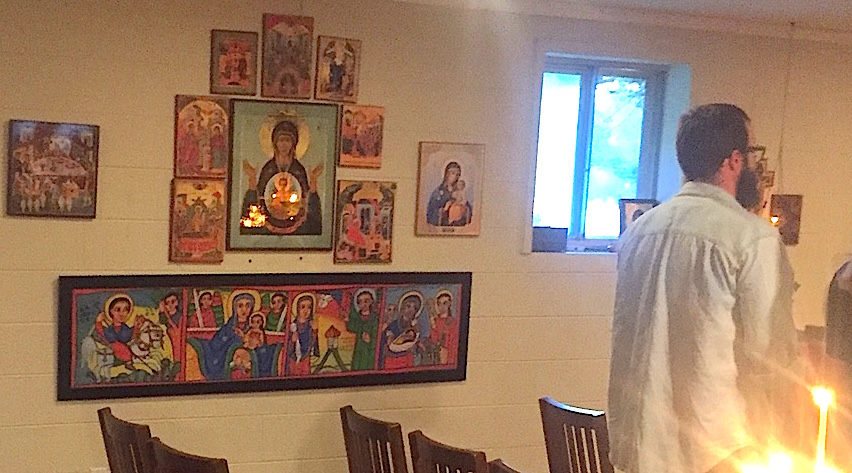
$10,000 – Sponsor hierarch and clergy visit
A bishop and two priests have already expressed interest in joining me in Ethiopia. My archbishop Alexander in this interview calls for American Christians to begin building relationships with Ethiopian, Coptic, and Oriental Orthodox Christians. Maybe you can’t travel to Ethiopia, but you have the means to make a major difference by sponsoring clergy from America to forge new ground in what could be a long-hoped-for reunification between these two ancient expressions of Christianity.
Reward: Any combination of the above items. Ha ha. We’ll talk.
Click here to give a specific amount of your choosing:
It has become popular in the last few decades of the American church to encourage Christians to discover their spiritual gifts. This trend, though generally positive, needs much clarification. This article seeks to delineate the various definitions of “spiritual gifts,” to outline what Scripture says on the matter, to describe the present models being used, and to offer another model that better adheres to what Scripture says about the nature of man.
What do we Mean by Spiritual Gifts?
Scripture gives a list of gifts or spiritual gifts in only four places. They are as follows:
Romans 12:6-9: “We have different gifts according to the grace given us. If a man’s gift is prophesying, let him use it in proportion to his faith. If it is serving, let him serve; if it is teaching, let him teach; if it is encouraging, let him encourage; if it contributing to the needs of others, let him give generously; if it is leadership, let him govern diligently; if it is showing mercy, let him do it cheerfully.”
I Corinthians 2:8-10: “To one there is given through the Spirit the message of wisdom, to another the message of knowledge by means of the same Spirit, to another faith by the same Spirit, to another gifts of healing by that one Spirit, to another miraculous powers, to another prophecy, to another distinguishing between spirits, to another speaking in different kinds of tongues, and to still another the interpretation of tongues.”
I Corinthians 12:28-29: “And in the church God has appointed first of all apostles, second prophets, third teachers, then workers of miracles, also those having •gifts of healing, those able to help others, those with gifts of administration, and those speaking in different kinds of tongues.”
Ephesians 4: I I -12: “It was He who gave some to be apostles, some to be prophets, some to be evangelists, and some to be pastors and teachers, to prepare God’s people for works of service.”
The Typical “Spiritual Gifts” Test
The typical spiritual gifts booklet will use all the seven gifts listed in Romans 12, and may or may not add several gifts from the Corinthian passages. Some may also include the category of “evangelist,” from Ephesians 4. A few booklets even add celibacy, hospitality, and martyrdom in their lists, since a verse may allude to one of these as gifts in a solitary instance.
To each category or gift, an extensive description or definition is given, each differing substantially from the others. Tests are developed in light of these definitions to see where people fit in the categories. While the names of the gifts themselves correspond directly to these Scriptural passages, the Biblical support generally stops there. The meat of these spiritual gifts tests are in the definitions of each gift, and for these definitions there is no real Scriptural support.
For example, the gift of teaching is defined by most booklets as a person who loves research, loves to understand systems, philosophy and theology and has a bent towards accuracy and precision. Apparently, someone with this gift may not necessarily be good at presenting these truths in front of a classroom. An excellent classroom teacher may be working from a basic gift of exhortation or prophecy.
These definitions are interesting theory, but there is no Biblical reason to define the gifts in these ways. Vastly different personality characteristics could be given for each gift listed in the Scriptures above. These definitions offered by the booklets are generally pulled from out of guesses based on the definition of the word in the passage, but guesses only the same.
Choleric, Sanguine, Phlegmatic, Melancholy
Another popular model for understanding giftedness uses the Aristotelian categories of Choleric, Sanguine, Phlegmatic, and Melancholy. Again, definitions for these categories have been pulled from the air. The contrasts are indeed interesting, and portraits of various Biblical characters are provided as illustrations. But the categories and definitions are not taken directly from Scripture.
What about the Supernatural Gifts?
It is clear from the Scriptures cited that these lists are filled with supernatural gifts. Groups that are uncomfortable with these supernatural gifts usually stick with those listed in Romans 12, with perhaps a few other safe ones mixed in. Even this maneuver is difficult, seeing that the first gift in Romans 12 is “prophecy.” With shaky reasoning, this gift is defined as pertaining to those who are outspoken, compelled to proclaim God’s truth, and willing to confront injustice. Thus, prophecy is kept from necessarily implying supernatural involvement.
Other booklets are very open to the supernatural gifts listed in scripture and include them all in their tests. This is a more honest way to construct categories. However, the definitions of these gifts are still rather ambiguous. A problem larger than fear of the supernatural makes all these various models inadequate for identifying human giftedness.
Looking More Deeply at the Issue
Seeing that these various popular tests have so little Scriptural support for their content, why are they so popular? Because our culture is starving for anything that hints at exploring the uniqueness, depth, variety, and grandeur of the human personality made in the image of God.
Let me explain further. Spiritual gifts tests, no matter how simple, do begin to delineate differences in human beings. When you take one of these tests you find out you are like this, not that, and you are not like people in all these other categories. You are different! You are special. You are needed. And you also need people different from you to complement you in your weaknesses. Something deep from within us testifies that these ideas are true, and indeed they are. To the degree that spiritual gifts tests bring to light this idea of human uniqueness, they are very helpful and positive.
The Pervasive Darwin
The reason we are so starved to get this message of our specialness and uniqueness can be traced to modern culture’s view of man. None of us usually realizes it, but we often operate, unwittingly, from an evolutionary, behavioristic, reductionist view of man in society. It has taken a century or two, but Darwin’s ideas of evolution (slime+ time = man) have permeated most of our institutions. This explains the medical community’s inability to quickly eradicate abortion or euthanasia. Why get upset if it’s only an animal?
This same reductionistic view of man has crept into our ideas of work and management. We view everyone as generally alike, “manpower” available to further the ends of production. The institution and its categories of labor are devised first, and the people are fit into these categories later. While our culture does think in categories of skill differences -a builder, a thinker, an artist – the main differential is in terms of hierarchy. That means you are either a line worker, foreman, supervisor, middle manager, executive, etc.
Power is the main difference in these categories. The better the person, the higher the place in the hierarchy, the greater the power. This “survival of the fittest” mentality is Darwinian evolutionary thinking.
So when a test for spiritual gifts gets beyond power games and begins to explore what gifts and abilities are inherently in us by God’s design, that gets us excited! It touches a knowledge deep within us that we are unique and special, made in the image of God, “fearfully and wonderfully made” as it says in Psalm 139.
Today’s Tests are Reductionistic
For this same reason, the Spiritual Gifts tests as we know them are not adequate. If indeed we are made in the very image of God (Genesis 1 :28), if we are “fearfully and wonderfully made,” if we are the crown and jewel of God’s created order, then certainly there is more splendor to the design of mankind’s personality than the present thinking allows for. Think of it-six billion people on earth, and only 20 or so categories to fit them in to! No, the categories for identifying and understanding the personality of a man necessarily need to be gigantic.
The typical spiritual gifts test used in today’s churches, while helpful to a degree and based in good intentions, are reductionistic. That is, they reduce the grandeur and splendor of God’s crown of creation, made in his image. Similar secular personality tests, from which many spiritual gifts tests are actually based, are also reductionist, behavioristic evolutionary models.
The Power of Naming
Every one of the six billion people on this earth is unique. Each has a unique set of fingerprints. Each has a unique tooth structure. Each face and every profile is distinctly different from everyone else’s. We believe (how could it not be so!) that every personality is glaringly unique as well.
But how do you go about identifying and understanding that uniqueness? This is where the fun part begins. When we identify the gifts and motivated abilities of our fellow human beings, we are doing the same thing Adam did when he named or classified the animals in the Garden of Eden. This ability to name is a distinctly human characteristic.
We use language to name things. In the English language we have over 20,000 words, plus all the combinations of those words in phrases and sentences. Each word, phrase, and sentence is a potential category. Now, finally, we have enough categories from which to begin to delineate and identify the absolutely unique personalities of our fellow human beings.
Introducing the Technology of the Doma Institute
The Doma Institute has developed a profiling technology that best reflects the Biblical uniqueness of humanity. It was founded by Ralph Mattson, author of several books including Finding a Job you can Love; Visions of Grandeur: Leadership that creates Positive Change; and Redeemed Ambition. Mattson’s clients for consulting in human resources range from Proctor & Gamble and Alcoa to Campus Crusade for Christ. He is considered by many to be the country’s premier expert on giftedness and management by design.
The Doma Group’s Individual Operating Style (IOS) profile consists of 65-100 words, prioritized and categorized in a way that demonstrates a person’s unique way of working and achieving. (Doma also has a more comprehensive profile called a MOTIF.)
By looking at the four examples, you can see how the profile is structured. These are profiles of three colleagues and myself in the mid-90s at the Chattanooga Resource Foundation. This organization conducted a leadership development program for several years where 50 rising leaders in the community—elected officials, businessmen, artists, educators, ministers, etc.—were annually exposed to a comprehensive biblical view of the community through various seminars and tours. Each graduate also received an Individual Operating Style profile and individual consulting on their calling and destiny for the community.
The “Role” at the top of each profile captures how a person goes about operating. The “Focus” section captures the material, subject matter, or “stuff’ the person tends to operate with.
The top line of Tony Souder’s profile says:
Relational, Supportive, Grower/Developer
The bold word in this top line is the key word. That means that if we only had one word in all the English language to describe Tony, we would have to use the word Developer. Fortunately, since we are not reductionistic and understand the need for more dynamic description for a man made in God’s image, we have more words to describe him. The phrase “Relational, Supportive, Grower/Developer” helps describe just what kind of developer he is.
Fortunately, again, we are not reduced to just this one phrase to profile Tony. We have four more below, in priority from top to bottom, to further clarify his operating style.
Relational, Supportive, Grower/Developer
Investigating, Focused, Practical, Attainer
“In the Action” Challenge Overcomer
Equipping, Innovative, Director/Coodinator
Encouraging Trainer
Notice Jonathan Rummel’s role. His key word is Leader. This sounds more like the typical human resource jargon we are familiar with. But you only have to go a line or two into his role before his uniqueness begins to unfold as well.
“In the Action,” Managing President Leader
Dean Arnold’s role captures an entirely different person. He is not managing and presiding nor growing and developing. He battles, lobbies, promotes, and impacts.
Conviction Driven Battler/Lobbyist/Promoter/Impactor
Doug Daugherty has still another interesting and unique way of operating. He solves problems by developing another conceptual initiative whose values help solve the original problem.
Overcoming Problem Solver by Development Rebuilding
to Implement Concept/Value
Can God make something so complex? Absolutely.
Each of these men do their role (top line, etc.) constantly. That means Doug Daugherty routinely solves problems via values projects when he is at home, at work, doing ministry, or at hobbies. He did it when he was young. He’ll do it when he is old. This is the way God made him to be.
Every person has an absolutely unique way of operating like this. This is God’s tremendous handiwork. Your particular unique design is what Ralph Mattson calls your “genius.”
What is the profiling process?
The method of the Doma technology involves capturing actual historical accomplishments in the person’s life where two things were true. One, the person enjoyed the accomplishment and, two, the person felt like he or she did an excellent job.
After analyzing and processing several stories of this type, a pattern emerges that reflects the unique, God-given operating style for that person.
The Doma Group has developed and refined this process on a professional level to meet the needs of corporations and of individuals seeking fine-tuned analysis of their gifts.
But the process itself is certainly not out of reach for the ordinary person. In fact, any of us can begin to evaluate people on this level by merely observing and appreciating what they do and how they go about doing it.
It is this very fact that gives credence to the authenticity of this model of human giftedness. Why would God make the tools for understanding our exquisite design unavailable until the 21st century? He hasn’t.
In a similar vein, the “Biblical support” for viewing human giftedness through the Doma model is much larger than the four sets of verses cited earlier. In fact, the Bible is inundated with support—because the Scriptures are filled from cover to cover with stories … of people!
The Bible outlines portrait after portrait of interesting characters, all different from the rest. Abraham is quiet and resolved. Jacob is deceptive yet maturing, Joseph is idealistic. Worldly-smart Moses is disillusioned, but gains the wisdom of the ages. Samson is volatile, fearless, and unfaithful. The list could go on and on, as could the descriptions of each character.
The accuracy of the Doma profile is strengthened by the fact that all information is taken from actual, historical events from the person’s life, not from an abstract, theoretical question on a test. A person’s identity is wrapped up in their history.
We even know God this way. He first identifies himself as the one who created the heavens and the earth. From Exodus to Malachi, he is the God who “brought you up out of Egypt.” In the New Testament, he is the God and Father of the Lord Jesus Christ, who died and rose again in history.
God has created a vast cosmic drama. Within that larger story he plants all sorts of individual stories in the form of human lives. The drama for each life revolves around the quest of each man to reach toward and fulfill the destiny God gave him based on the intricate mix of gifts designed for him at the start. Certainly, each of us could go through life and never quite tap into our unique design. It happens all the time. But those of “royal” status will reach forward to find their destiny:
It is the glory of God to conceal a matter.
It is the glory of kings to search it out. (Proverbs 25 :2)
So What was Paul Saying?
The verses quoted at the beginning of this article need to be considered now in light of the understanding of human design and giftedness which have been outlined in this treatment.
This writer’s opinion is that the body of Christ works through created motivational gifts along with supernatural gifts laid over top.
In other words, we first need to work at understanding who we are in terms of the giftedness design given to us early on as humans. This concept in itself could revolutionize Christian ministry and our culture around us. The complexity of a human body —DNA, cell structures, immunities, balance and aesthetics, etc. – is analogous to the complexity involved in our aspiring as a corporate entity to appreciate and act upon our glorious, complex designs as individuals.
There is a world, a millennium, of worthy activity and challenge, in just tackling a working model of the body of Christ based on these motivational-design gifts. It may be that in Romans 12 Paul is listing mostly motivational gifts and being descriptive, not exhaustive, when he lists them. In other words, he was basically encouraging the church to work together as a body and meant, to paraphrase, “Do whatever your gift is, and I’ll name a few so you’ll get the idea.”
The other scriptures (and possibly Romans 12 as well) point to a supernatural type of gifting that the Holy Spirit gives to his people to build each other up in the faith. I believe these gifts are distributed “overtop” the motivational-design gifts. Certainly the two types of gifts can work strategically together, through God’s providential wisdom—a more incarnational model. And certainly, the complexity of these supernatural gifts may reach that of the other gifts we have outlined.
Although I am a believer in the supernatural gifts of the Spirit for today, the scope of this article does not allow me to pursue the many further questions regarding their usage.
Having said that, I think the bride of Christ has a great deal of maturing to do in both areas of giftedness—motivational-design gifts and supernatural gifts. This article is a charge to grow and mature in the practice of the motivational-design gifts. They have been given to us by God to help us work together as a body.
Whatever the focus, be sure to enjoy the Lord and his exciting plan of giftedness as you go. ■
Dean Arnold served as Director of Public Policy and Communications at the Chattanooga Resource Foundation in Tennessee. He was also an associate with the Doma Institute and oversaw the profiling of rising Christian leaders in politics, business, education, and ministry through the foundation’s bi-annual Leadership Development Program.
This is an interesting email correspondence I had recently with the son of Jim Rayburn, founder of the ministry Young Life, which has affected millions of lives. It involves the grandeur of Jim’s character, but also a lot of detail of my own spiritual journey to Orthodox Christianity, and how they tie together with my Young Life experience. (Jim III responded as well, which I didn’t include. Below is a combining of a couple of my emails to him.)
Hi Jim III.
I just finished my third reading of Dance, Children Dance, the great biography you wrote about your father, Jim Rayburn II, founder of Young Life. It’s on my top three of all time favorite books. I am a writer and historian by trade. Not only is Jim II’s incredible and complex life great subject matter for your book, I also love the way you crafted it. Great insights, honest, full of the greatness of contradiction, and captured with such great minimalism.
I am the son of a PCA minister who attended Dallas Seminary, but I came to know Christ personally through Young Life in Roanoke, Virginia in 1981.
I attended Covenant College, and so was also shaped by another Rayburn, Jim’s brother Bob. I wonder what their relationship was like.
I also wonder how Jim did with his pop, the staunch Presbyterian, later in life. Your book doesn’t say much past the early years.
My journey has included the Baptists, non-denoms, the charismatic movement, and house churches. For 20 years I have been Eastern Orthodox, which historically emphasizes a direct personal relationship and encounter with God (as opposed to Western rationalism) but also, obviously, still puts a premium on liturgical forms and the institution of the church.
Orthodoxy almost seems like a fusion of Jim and Bob Rayburn. Anyway, that’s the line of my questions that I would love to explore with you, either by email or phone.
The first marking I have in your book is page 58, an except from Jim’s journal:
“I have a deep and abiding feeling of his presence, a sense of real yieldedness to him, dating from a special experience of surrender and dedication to the Eternal Light, which I experienced Saturday night in my room. Oh for words to express!”
And this is appropriate. This is clearly where the story begins.
Something happened to your Father that night. He had an encounter with the Living God. Apparently, it only takes one, because his life after that was nothing but a whirlwind of craziness, of both unimaginable blessing and very deep pain.
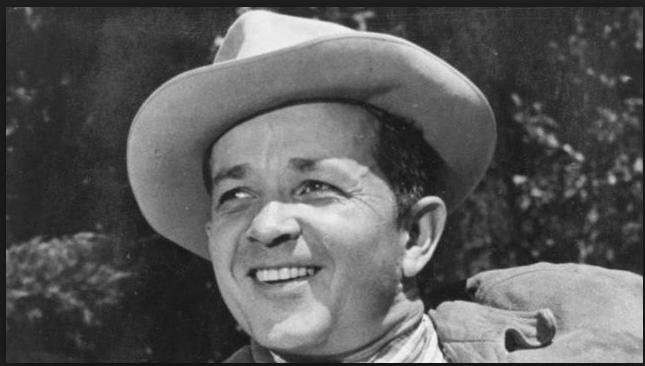
This is why I am drawn to the book. Because it’s not just another great biography. It’s a story of a man that was actually touched by God. I think it’s what we all yearn for, what we were created for, but, as you know, the path for this road is very narrow.
On the positive side, there are the all night prayer meetings, the churning within him to share Christ with everyone, the large crowds of young people turning to Christ, the ridiculous visions for great properties and over-the-top-excellence for teenagers. And, finally, the part that always intrigues me: his prayers at the end of his life for those behind the iron curtain—and I believe a picture of him walking and praying along the wall. He was so near to God’s heart he was 20 years ahead of everyone in geopolitics regarding world history.
On the pain side: regular migraines, tragedies, an unsympathetic wife, being struck by lightning, near death from stomach problems that plagued him throughout, addiction to pain meds, and the inability in his later years to perform physically and speak publicly.
The fruit of his amazing faith in my life—and the trials and pain he must endure to pull it off—did not blossom until 20 years after he died.
Much of my life the past 35 years has been an attempt to experience that same Eternal Light Jim speaks about. I’ve had glimpses. A couple of college friends and I encountered the presence of the Holy Spirit as we attempted to intentionally love each other and dedicate ourselves completely to Christ. Upon graduating, we moved on and did what everyone else does: find a job, look for a woman to settle down with, pursue happiness with God’s endorsement.
But a couple years in we weren’t able to continue with that plan. My two buds had an experience in St. Louis with a friend who was exhibiting demonic tendencies. They took him to a guy who exorcised the demon. Our group had encountered something beyond the normal dimension. A few weeks later I left my excellent opportunities in Orlando, Florida, and moved to be with my two friends. We determined to pursue “revival” and “the Kingdom of God.” We weren’t sure exactly what that meant (and I’m not sure I still do, completely), but we took every step we knew how in order to get there.
We ended up all moving to Chattanooga, Tennessee (where I still live) and began to experience a few things on a very light level of what you describe in Jim’s life. We gathered many young people together regularly to praise and worship God. Unbelievers gave their lives to Christ. More demonized people got delivered, and some of them exhibited the same sensational stuff you see in the movies, and read about in Scripture. Other gifts of the Spirit were manifested. We experienced the real deal. (Keep in mind we were Reformed Presbyterian Covenant College kids whose parents were leaders in the church—my Dad a card carrying PCA minister with a doctoral from Dallas theological seminary.)
We called our quest “the vision.” We knew what it meant, but we couldn’t always exactly articulate it. Was it simply miraculous activity? No, it was more than that, as you suggest in your previous email. It involved a desire to be in complete relationship with the Living God. To experience union with Him. To have a singular focus on the One we are called to love as our first commandment. In involved not letting money, love, passion, romance, family, careers, or any other “grown up” activities keep us from that goal.
The purity and fire of those early days lasted a handful of years, depending on how you count it. Various personal problems and career moves caused both of my close friends to move away, right around the same time.
I found myself trying to continue this “vision” on my own. I got involved with Vineyard Christian Fellowship and other Charismatic and spiritually awakened types. I also became a cultural warrior, providing leadership in pro-life and pro-family battles, and the excitement of that arena helped ease the pain of the slow decline of the other. My culture war mode of ten years got a big kick in the gut when I suffered a divorce around 2000. My qualifications for leading a pro-family movement were lessened and I was now technically disqualified from leadership in conservative churches.
What to do? I founded the city’s first Jazz Association. I wrote a couple of great books. I did whatever I could to stay in relationship with my two children. At that same time, I was meeting with a friend at a local coffee shop who had become Eastern Orthodox. He had been an elder and youth director at a hip Bible-believing church in town, then started Urban Young Life in Chattanooga and did other cool stuff. A guy I truly admired.
His explanation of Orthodoxy answered certain questions I had been asking for a long time, since I was converted through Young Life as a teenager. Who makes the rules for church? Who gets to run this thing called church? Why? Who says? Do we even have to do it?
I figured out early on that Martin Luther had let the genie out of the bottle. If he could defy church authority, so can his followers. And thus we have 30,000 (or more) Christian sects today in America. I had grown up watching my Dad go through several church splits. I didn’t know who was right. I didn’t really care if he was right or not, I was just frustrated that there didn’t really seem to be a way to know. Every faction always has an argument from Scripture.
I knew that becoming Catholic could solve the problem. Apostolic succession was a great argument for the conundrum. But I didn’t want to be Catholic. So that was that.
My coffee shop friend enlightened me that the Orthodox call Catholics “the first protestants.” The Western Church and it’s bishop (the Pope) broke away from the mother church in around 1000 A.D. Why? Ostensibly over the supremacy of the Pope and the “Filioque,” a Latin word in the Creed. (I talk about this in detail in some articles that I’ll link below.)
But Orthodox leaders will say the ultimate divide between East and West is the East’s insistence on mystery and the work of the Holy Spirit and the West’s decline into rationalism, intellectualism, and hierarchy. I was attracted to that proposition, but my becoming Orthodox really centered around being able to embrace Apostolic Succession without becoming Catholic. (I knew something didn’t smell right about those guys.:) )
I wouldn’t have been able to think outside the box like this had I not gone through a divorce. I got more involved, and a funny thing happened, which still intrigues me to this day: for over a decade I would never give any church the first thought if they didn’t pass my first litmus test—do you believe in the gifts of the Spirit? If they didn’t, I just didn’t have time for them.
About a year into Orthodoxy, I realized that not only had I not demanded that litmus test, I wasn’t even asking the question. Now why was that? All I can guess is that the fullness of the Spirit that the Orthodox claim to maintain in their worship, and their emphasis on mystery, was affecting me. I felt God’s presence. It was a different type of experience and sensation. It was more humble, more emphasis on my penitence, more focus on the presence of God in the Holy Trinity and worshipping him, less emphasis on my personal experiences and personal “trip.” But it was real, and it was drawing me in, despite my previous alleged need for sensational and miraculous doings.
That’s not to say the Orthodox don’t believe in the miraculous. They surely do. We have prayers for healing and exorcism, and stories of their happenings. We honor saints who levitated, we believe that every Easter a fire comes out of the tomb in Jerusalem and lights every candle in the congregation (I’ve seen this on Youtube). We believe some icons weep myrrh. We believe some kids in the 8th century fell asleep in a cave running from persecution and woke up 200 years later. I tell my Pentecostal friends that our miraculous weird is way weirder than their miraculous weird. But it’s not placed on the center stage. Often such activity, or reports of ecstatic visions and encounters with the Divine, are done by monks who earn their stripes praying in caves for 30 years. And they try to keep it quiet.
So this journey of Orthodoxy has become real for me, and it has become fulfilling. I sense a unity with God’s people all across the globe. I feel miles closer to Jesus’s prayer that we all be one. This church is usually persecuted, it comes in many colors and ethnicities, and it is often poor. It follows all the difficult teachings regardless of consequences. It looks and smells like Christ. There are exceptions, but I think the generalities are true.
My gifted, longtime friend, the first to move away, saw this reality in my life and joined me in 2010, becoming chrismated and taking vows into the Orthodox Church in St. Louis. Three years later, he became an ordained Orthodox Priest. (I cannot go on that path because of my divorce.) We both believe that somehow Orthodoxy is a fulfillment of our original journey, but we cannot completely articulate it yet. We both believe there is likely more experiential stuff ahead of us to help tie our story together.
For years, I have thought that perhaps we are dealing with what Christ told the Samaritan Woman: There is coming a time when my people will worship me in Spirit and in Truth. I have experienced tastes of the Spirit, but without a good foundation. Perhaps the Orthodox Church is this Truth part of the formula. As the Spirit continues to descend, I hope to see God’s Kingdom in a much more full and successful fashion, with the proper foundation having been laid.
Was Jim the victim of being touched by the Spirit, the “Eternal Light,” yet living in a Western Christian culture that has systemically quenched the Spirit and instead chosen Rationalism and a non-mystical institutionalism? I wonder.
There’s a lot more to say about that. But I’ve given you enough of my story to chew on.
On the matters of your father and Grandfather, and their relationship—who is still living that can be interviewed on that question? That father/son relationship is so complex and layered. I am intrigued that Jim in some ways rebelled from his Dad, yet at the same time he ended up being the same thing: a Christian Evangelist. But did his Dad even affirm that?
I chatted once with Bob Rayburn Jr. (or is it the Third—anyway, the son of the Covenant College founder) on this matter, and he told me he was divided on the whole thing. “When I talk to my kids, in some ways I want them to be like Dad,” he said, “and in other ways I want them to be like Uncle Jimmy.”
Another somewhat sad story: I met at a pool party about a year ago here a young man who is Bob Rayburn (the Covenant Founder’s) great grandson. I told him everything I knew about his amazing great uncle. He had never heard of him. I recommended your book.
You may know another friend of mine. My last Young Life episode was working a few clubs here in Chattanooga in the early 90s. A friend here named Dan Parker rounded up a few of us fired up young guys and got us to help him do Young Life with him. Turns out he was the last group of three kids that your Dad took under his wing, later in life. They called him “Jimmy Ray.” Dan had a few funny stories, and one particular story of how one night Jimmy Ray took them somewhere and instead of all the fun they were used to, he said, “Tonight boys, we’re gonna pray. We’re gonna pray.”
Dean W. Arnold
You can’t just fly out Thursday into Mexico and back again Friday to get some prescription drugs. That would make your trip too short. It costs an extra $300 to do that. No, you must stay over into Sunday. You pay for this discount by having to stay in Mexico several more days.
Of course, you could spend most of your time in cosmopolitan Yuma, Arizona on the border, where I flew to from Phoenix. But it’s about the same thing. Nowheresville, nothing to do, hot as blazes and a foreboding and ugly countryside. The forecast for this Sunday, May 6, is 107 degrees.
The mission is simple and straightforward: buy $8,000 worth of prescription drugs for me and Dottie, both uninsured, at a pharmacy just across the border that charges 85 percent less than the inflated costs of America’s Big Pharma racket. They sell the exact same drugs. Same package, same company, same manufacturer.

They say this is perfectly legal. And they say crossing back into the USA with all these drugs is no problem. We shall see.
My reward for six hours of flying each way is to experience my first trip to Mexico. As you can tell from my first sentence, it hasn’t exactly gone the way I had imagined.
Other than walking past a funny sign at the border that said, “Guns are not allowed in Mexico,” the first few minutes of my Latin American adventure actually went pretty well. The big “Purple Pharmacy” that sells just about everything Americans need was about 30 steps across the border. The employees spoke good English, very friendly. I bought everything I needed for $1,016.00, which sounds like a lot, but not when you realize that would have been one month’s worth of our Obamacare premium (had we signed up), with only a $19,000 deductible. I kid you not.
I travel light. I have a big leather satchel briefcase with a handful of clothing items, a couple books and a laptop and a few cigars. Everything I need in life. On one of my three trips to Ethiopia, I only took this satchel. However, when I bought all the meds at the Purple Pharmacy, I now had two big purple plastic bags full of drugs in my other hand. No more fancy-free Dean. I now had to travel carefully and strategically.

My phone stopped working. That means I have to find some wifi so I can figure out my method for getting to the large city of Mexicali, nearby my current town called Los Algodones, just across the border. I had booked a hotel in Mexicali. But as I started walking the streets and asking around for a coffee shop with some wifi, I learned lots of things very quickly:
Mexico reminds me a lot of Ethiopia:
I also quickly saw the differences. Mexico doesn’t have Ethiopia’s big redeeming value—a glorious 3,000 year Judeo-Christian heritage. They also don’t seem to drink much coffee. Wifi could not be found. More practically at the moment, most people don’t speak English.
As the ugly American, I was a little shocked by this. Most of my traveling has been in Europe and Africa, where most everyone speaks English. Some Europeans don’t speak it so willingly, but Ethiopians of all stripes, rich and poor, are darn right enthusiastic about engaging you in the King’s English.
So now I found myself asking people questions on the streets of Los Algodones, but not having much luck. One guy at the liquor store across the street said the Purple Pharmacy actually had wifi but no coffee. He sent me five blocks in one direction for coffee and wifi. They had coffee but no wifi. I came back to my original Purple Pharmacy destination, because wifi was more important now than coffee. As it turned out, the Pharmacy had coffee but no wifi. I asked around, and no one could help me.
With no phone service, and with the inability to get help from other people, wifi became rather crucial. I just started walking around, both hands full of big bags, hot as hades. It was easy to see why all those Westerns were made that involve people roaming around in the desert about to die of heat and thirst. And it was only 9 am. I passed a couple of guys who tried to sell me belts and hats and other trinkets. I told them I needed wifi.
“I can get you wifi for twenty dollar,” he said. “For a whole year.”
“I need it for five minutes.” I said, and kept walking.
A lady near to them, maybe their sister, but an angel by my standards, pointed to a restaurant: “They have wifi.” The two men sneered at her.
This little spot met all my needs. I had Houvos Rancheros. It was sort of mediocre—I’ve had better in the states. But I found some electricity and surfed to find out how to get to Mexicali, the capital of that state in Mexico, Baja California, and a city of one million, a thriving cultural center, or so I had been informed by the internet earlier in the week.
Two bits of bad news.
1. My earlier intel said Mexicali was 4 or 5 miles away. No, it’s 60 miles away. I’m not sure how I goofed that up. However, this dilemma could be easily solved by just deciding not to go to this Baja mecca at all and stay put in Los Algodones.
2. Second bit of bad news: my deadline for canceling the hotel in Mexicali had past.

So, since I had already bought a hotel in Mexicali, I determined to properly finish the two extra days of Mexican punishment for my flight discount and asked around where to catch the bus. By the park, someone said in broken English. As I walked to the park, by George a bus pulled up right at that very moment. I asked the driver several times if it went to Mexicali and he ignored me. But a kind old man behind me told me it did.
I got on, and he got on behind me. I didn’t know what it cost, and the driver couldn’t speak English. The kind old man said it was $3.00, about $17 less than I was expecting. The driver broke a $5 bill and I gave my second angel of the trip the other $2.
Mexicali is 60 miles away, but it takes the bus two hours. Whatever. I was in for the long haul. I’m here to experience Mexico, and observing the vast countryside is part of all that.
Well, the countryside sucks. And the bus has no air conditioning. I was rescued from all this by listening to “The Civil War” by Shelby Foote, which I had smartly downloaded to my phone and therefore was not dependent on wifi or cellular.
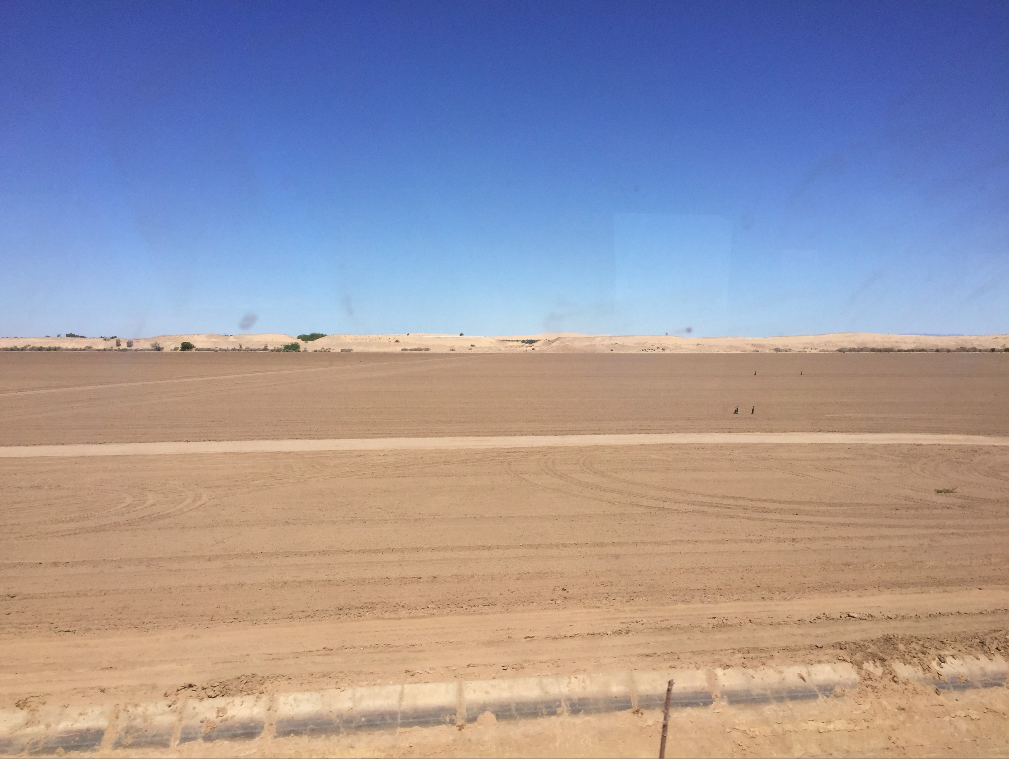
I also recalled that my great grandfather, Clarence Arnold, had in fact moved to Mexico for a few months to consider making a life there. His family of eight had been in Arizona for several years where he killed 44 rattlesnakes in his first year on his ranch. The landscape there and in Mexico all looks kind of similar. Arid, desert and sand, mixed in with brush and a few palm trees. Absolutely uninhabitable mountains looming on the horizon. I don’t think you could camp in this terrain. I’m not sure how Clarence did it or why he ever really wanted to.
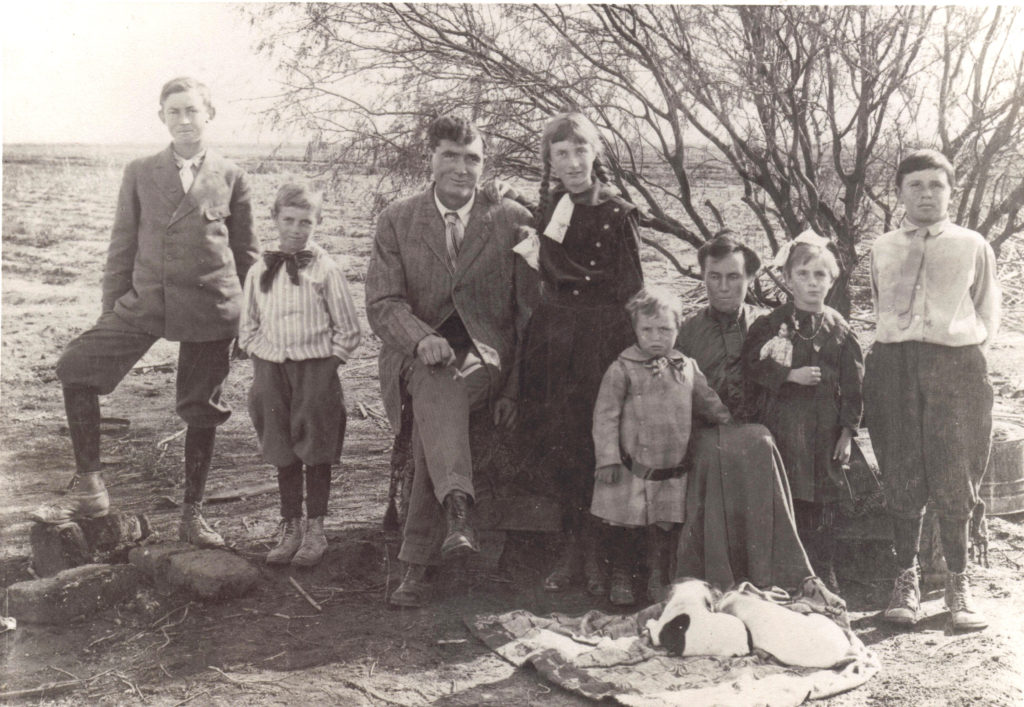
As we neared the Mecca of Mexico, it started to more resemble the urban sprawl of Atlanta, but dingier. McDonalds, Starbucks, Walmart and Sam’s were all represented. The bus driver dropped me off and I walked across a four lane highway with all my bags to the Motel Marche that I had repurchased at a price higher than I wanted—but felt like risk taking was a bad idea for my first night in Mexico.

The Motel Marche apparently is the drive-in theater version of lodging facilities. I walked around several times looking for a lobby or receptionist and could not find one, only little roads and driveways and garage doors that looked like storage bins. As I walked around the third time I heard a voice over a microphone that sounded like Darth Vader admonishing me. There to my left was some kind of window with a drawer, like a drive thru bank teller. Someone was calling out to me in Spanish. However the window was like a mirror, I could see nothing. We started shouting at each other, in two different languages. She opened the drawer and asked for things. I started showing her confirmation numbers on my laptop. It was getting hot. I was getting hot.


Finally, some young Mexican girl appeared around the corner, like the little man in the Wizard of Oz, and we communicated by gesture. After viewing my license, she presented me with a bill, higher than I had agreed to, and I gave her a $100 benjamin. It took her several minutes to give me change . . . in pesos. And that was it.
“Number 3” she said, indicating my room number.
“My key?” I asked. She shrugged her shoulders (at least I figured she did, because I couldn’t see anything behind the window). I finally figured out that they don’t do keys. This is all very interesting, because I did need to actually GET INTO THE ROOM. Finally, she walked over with me to #3 and let me in. I thanked her very much and gestured the sentence, “How the hell do I come and go with no key?!” and she gestured back that I shall come back to the Darth Vader window every time and go through the very easy process of getting them to let me in.
The room itself, however, was a contrast in extremes. While the countryside is awful, the room is elegant like Scarface’s mansion. As modern and chique as they come. However, it took a few lessons to get the TV turned off, and despite having four wifi modems, the girl couldn’t get any of them to work, and they had to call in another lady to give me a pirated passcode from a neighboring wifi system.

Having enjoyed a couple hours of refreshment and wifi regrouping, I embarked on the heart of my purpose in Mexicali—experiencing Mexico. I told a cab driver to take me to the historic district for tourists. He looked at me strangely, either because he did not understand my English or did not know what an historic district for tourists would mean in Mexicali. Probably the latter. When he took me to the spot, he asked me if I wanted to be dropped off there. It didn’t look like Mecca. He decided to take to me to the nearby “plaza” but that ended up being the mall. We went back to the original “authentic” location. I wanted authentic, and I got it.
Amidst the dusty electronic shops and tire stores, I did see a large steeple of a cathedral. I walked around the inside of this Catholic church for a few minutes, observed the statues—one particularly unique one with an archangel defeating a demon and its feet—and bought a trinket in their store. This, apparently, will be the cultural highlight of my experience in Mexico.
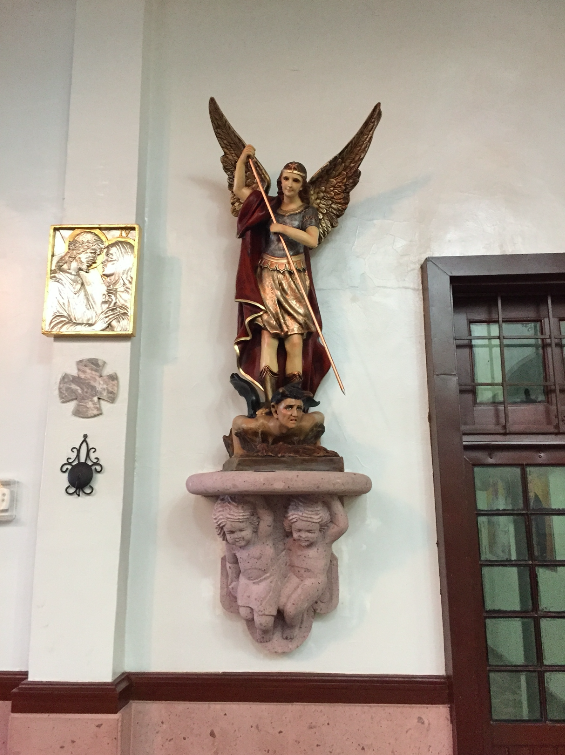
This was confirmed a few minutes earlier by a Chinese lady I chatted with briefly. She ran a huge restaurant where I decided to eat a late lunch. Internet research showed that Mexicali boasts the country’s largest Chinese population with a Chinatown that rivals San Francisco’s. I had my cab driver take me to “a good Chinese restaurant.” I couldn’t understand the menu, so I trusted this lady who recommended several items: wonton soup, egg rolls, and teriyaki chicken. She ordered me the large portion on every item, capable of feeding four people That $8.99 meal in America cost me $40. Upon leaving, I asked this lady where I could see some historic buildings and stuff and she said, “They don’t have anything like that around here.”
I haven’t had a chance to experience an authentic Mexican restaurant yet . . . or maybe I have. It’s Saturday morning, and I have until this evening to travel back to the border town of Los Algodones and cross the border itself before it closes at sunset. Hopefully, they won’t care about the large bags of drugs I’ll be carrying.
When I awoke this morning, the hotel’s wifi didn’t work. There’s no place to walk to for breakfast, and besides, the Mexicans don’t really drink much coffee and I don’t think they do breakfast either. I had sort of given up on Mexicali when the cab driver asked me where he should take me.
“McDonalds,” I said.

On my last visit to Ethiopia, the Academic Vice Dean (basically the head man under the bishop) told me they have great difficulty obtaining theological books for themselves and their students.
Levi and I made a serious effort to bring them books. But our boxing job was pretty lame. (Two boxes, actually.) Would they make the two-leg transnational trip?

The Ethiopians can’t even obtain these theological books online. Ethiopia is treated differently by the Amazons of the world, as the government doesn’t always play ball with the global corporations. (You don’t see Starbucks or McDonalds either, although Levi has scored several bottles of Coke so far.)
Protestant and Catholic books can be obtained, but not Orthodox theological books. They particularly want books by Russian mystical theologians, and more particularly a group of scholars who fled Russia after the Bolshevik Revolution and set up shop in Paris for a generation before landing in St. Vladimir’s Orthodox Seminary 45 minutes north of New York City. Some of you may know the names: Schmemann, Meyendorff, Lossky, Florovsky, and others. Continue reading “Taking books for granted (day not sure – Dean in Ethiopia)”
Levi and I just finished up the biggest festival of the year in Ethiopia—well, the eve of the feast. More tomorrow.
Timkat is Theophany (sometimes called Epiphany) when Christ was baptized by John the Forerunner. Millions turn out all over the city to head to a water source to recreate the drama and also the event of the Ark of the Covenant being brought into the Jordan River to cause it to recede and allow the children of Israel to proceed into the promised land.
Continue reading “Christ is baptized! Timkat 2018 (day 3 – Dean in Ethiopia)”
“I sought for the greatness and genius of America in her commodious harbors and her ample rivers – and it was not there . . . in her fertile fields and boundless forests and it was not there . . . in her rich mines – and it was not there. Not until I went into the churches of America and heard her pulpits aflame with righteousness did I understand the secret of her genius.”

This famous quote about America in 1835 could be written about Ethiopia in 2018.
For the next several days, we will be visiting those churches.
French scholar Alex de Tocqueville’s words about America pinpoints pulpits, and while many Ethiopian leaders speak out for righteousness, it is the 2000 year traditional practices of the church that so inflames the populace of Ethiopia with righteousness. Continue reading “The secret of Ethiopia’s greatness (day 2 – Dean in Ethiopia)”